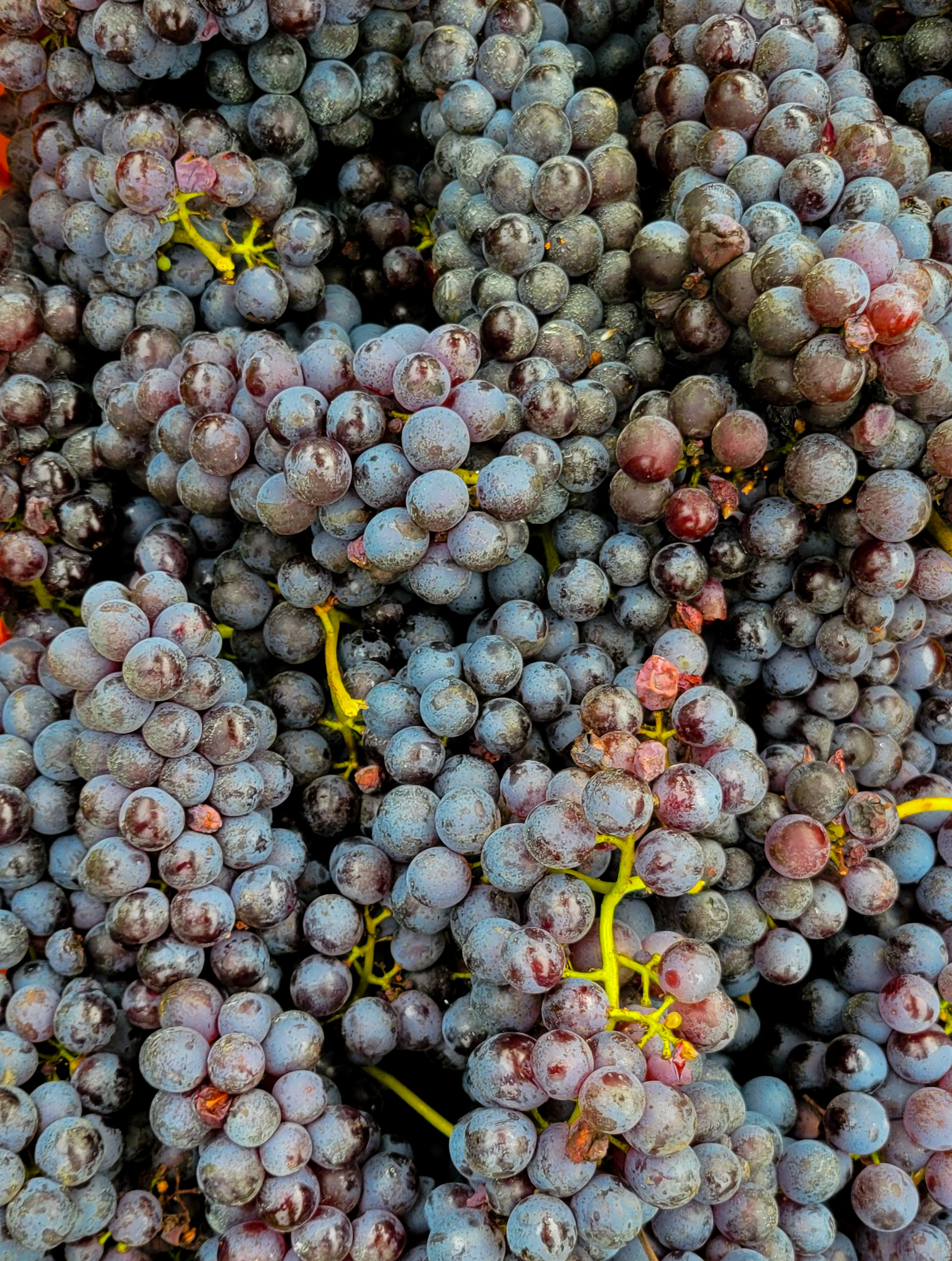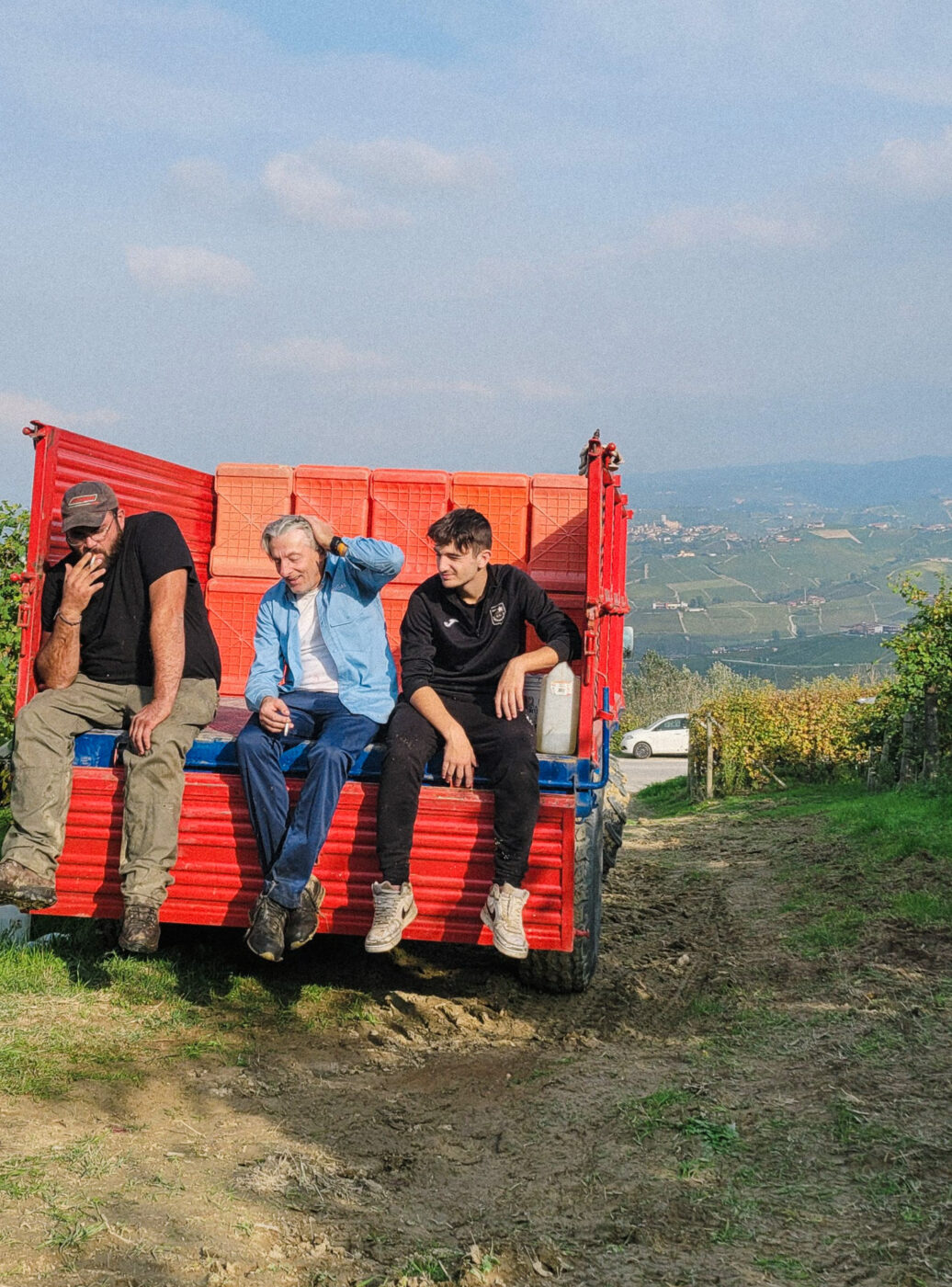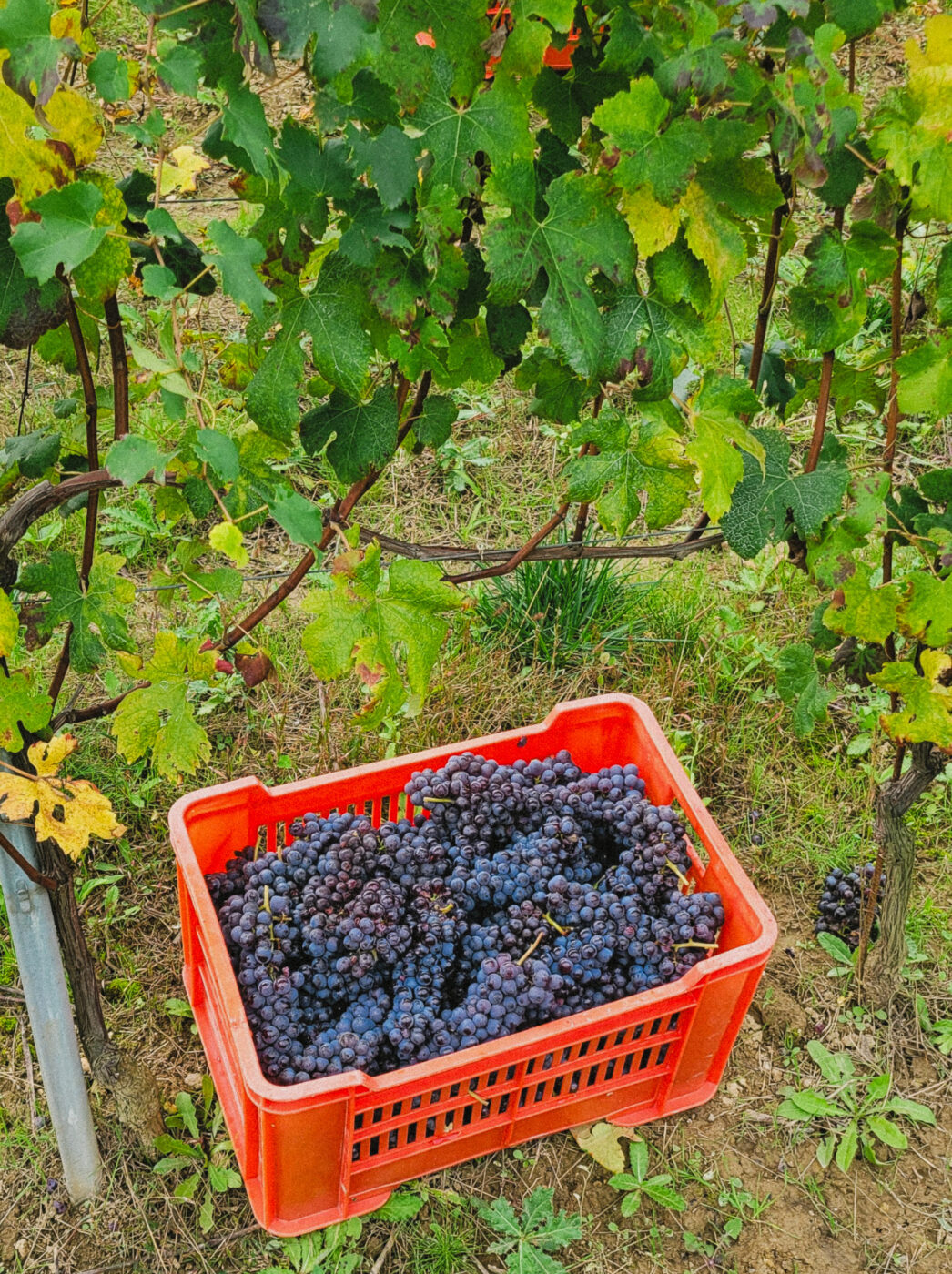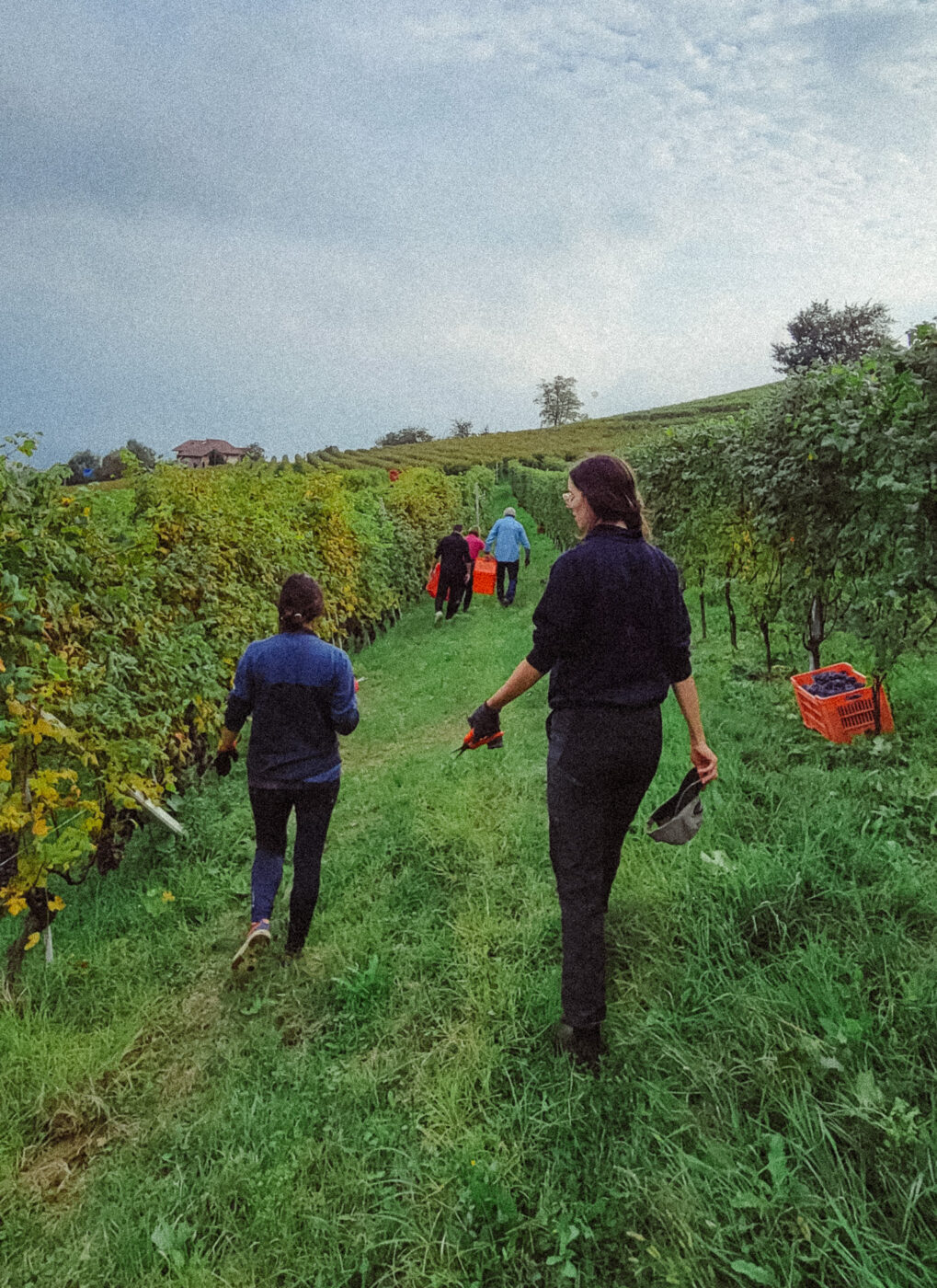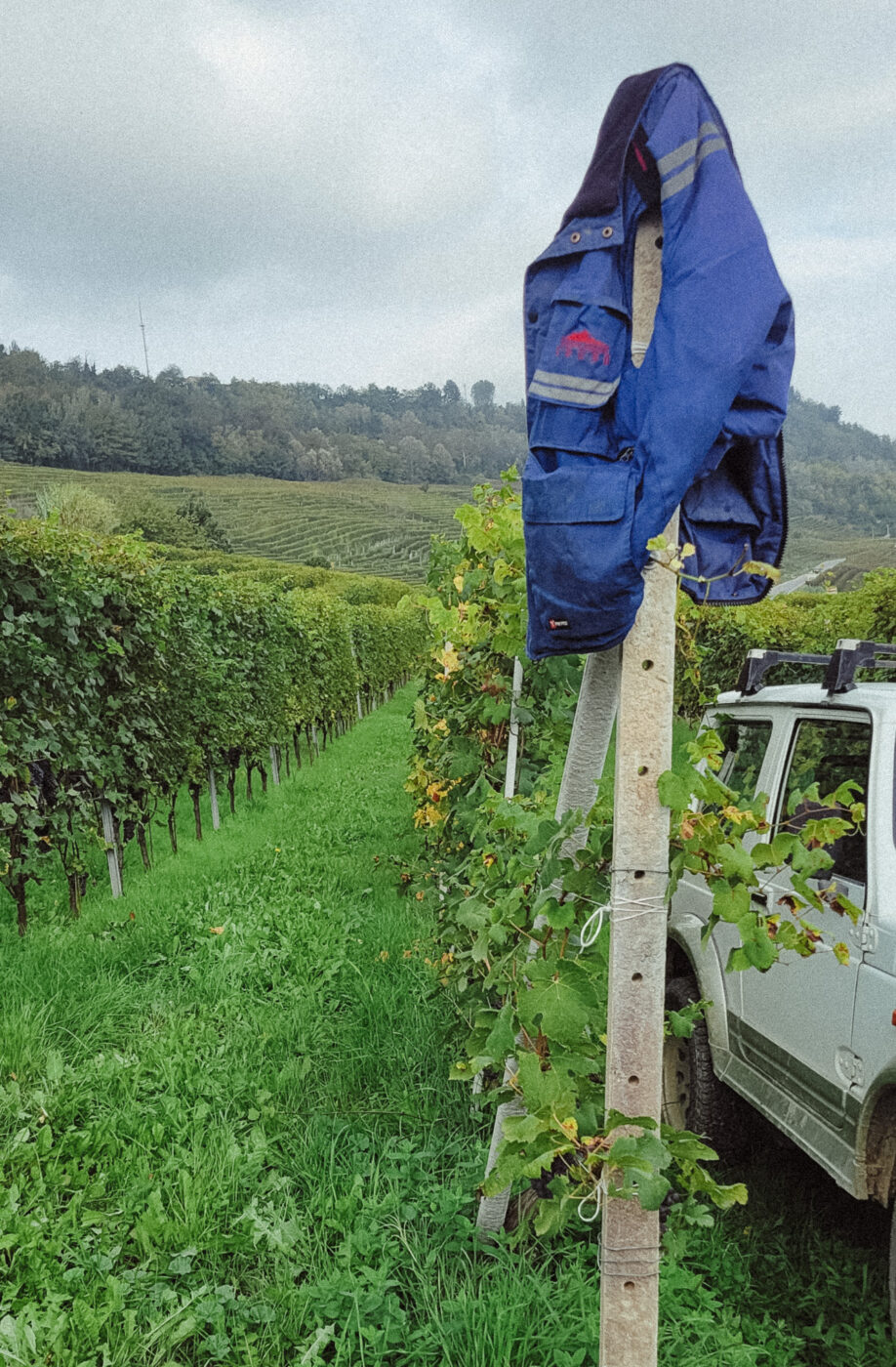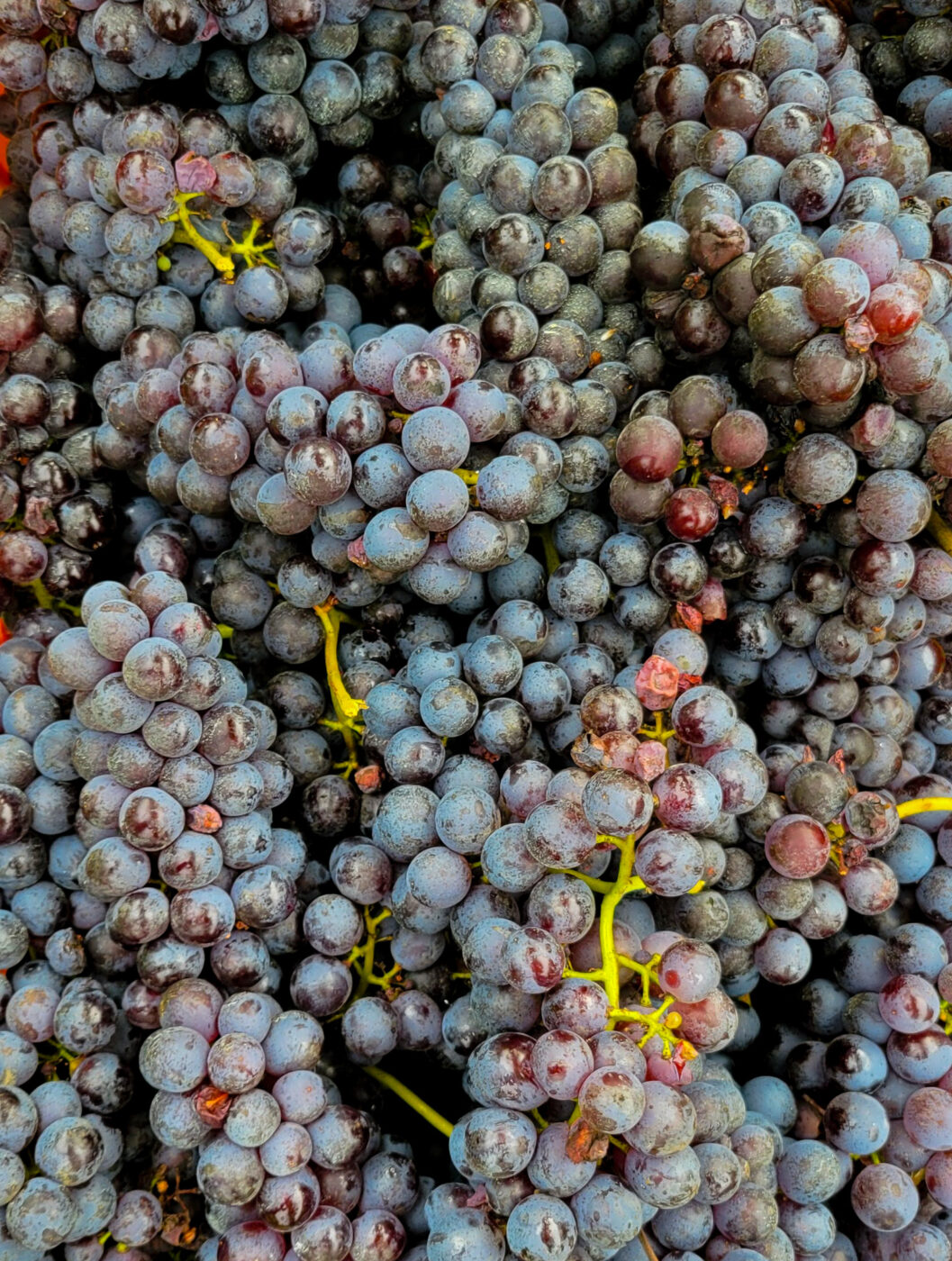There’s an overcast grey sky above, backlighting the warm, heated room as wispy rain sprinkles the landscape outside of these windows–another Piemontese autumn afternoon. They’re not all like this one, but this weather is far more indicative of this year’s difficult vendemmia.
Upon pulling up any regional wine producer’s Instagram, it’s a pretty sure bet photos of their vineyards with captions recounting the weather will appear: heavy, prolonged rains followed by random hail and unexpected breaks in bright sunshine, quickly removed by overcast skies and lower temperatures. Producers are hesitantly alarmed, slightly nervous, and realistically tuned in to the continuing climate crisis that the world faces every day. They see this through their grapes–beautiful grey-ish purple-ish bunches, proudly bearing the names Nebbiolo, Barberba, Dolcetto, blemished with clumps of mold and dried up fruits requiring bonsai-level precision trimming.
How do I know this information? I’m not a producer, nor a farmer, nor do I own any property, let alone vineyard property in Piemonte. I am only a consumer (a lady of the reds, as my local enoteca proprietor describes my tastes). This year, though, I role-played vineyard worker and joined the vendemmia. This work is beautiful and excruciating: my hands are still slightly achy with ghost cramping from the precision trimmers, my hiking boots still stained with grape juice, my overalls scuffed and marked by the harvesting bins. What distracted from the physical work was the emotional intervention of conversations among the workers–some family, some friends, some seasoned, some new.
Writing about wine is a particularly difficult endeavor. Not because it isn’t feasible–it certainly is. Almost always, however, there are specific lenses through which to talk about wine: through the vines, their growth, their challenges; through the producers, their work, their struggles and successes; through the wine, a product steeped in industry definitions and tasting notes, sometimes accessible, other times incomprehensible. To write about wine as an experience, as a business, as a family venture, as a delicate financial risk, as a rewarding effort, as a part of daily life in the Piemonte, well… this is more storytelling than journalism.
Viviana, a friend and girlfriend of one of my coworkers, picks me up in her red Fiat Panda in Bra and we swerve our way up into the hills of Vergne. It’s a perfect day in Piedmont–sunny, mildly crisp, and the thinnest sheet of clouds providing coverage that illuminate the verdant vines quilting the hills in this region. We pull up to the side of a road framed by two slopes and park, leaving the little Panda almost on a teeter, and unload. I’m dressed in a hybrid fashion, unsure of exactly how to prepare. I look like something between a gardener and a woodsman, overall-clad and tied snugly into my hiking boots.
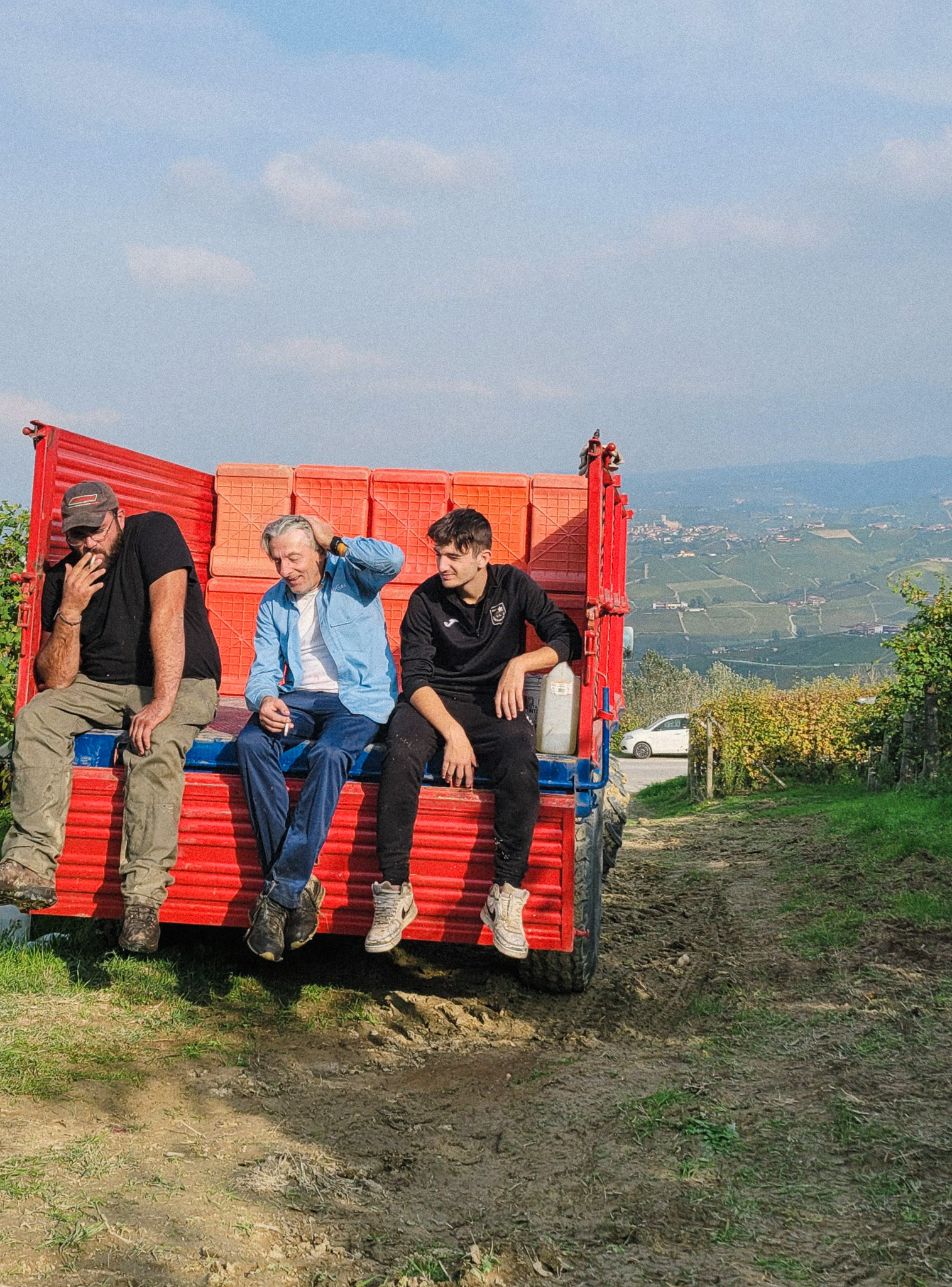
Viviana’s family owns four hectares of vineyards between here, La Morra, and Barolo; the grapes grown on these properties are bottled under their label Vaira Aurelj. It’s a small production. Her two brothers, Francesco (affectionately called Coco by his friends and family) and Giacomo, run it now, their presences complementary to each other. Francesco is a burly man, almost always with soil-soaked fingers holding a cigarette, and his features are hidden by a brunette beard, glasses, and a ballcap, the quintessential vineyard man. Giacomo confirms this, telling me Francesco prefers to work with the plants and the land, while he–a more slender, younger and clean-cut guy in comparison–prefers the production process of making the wine itself.
I don’t meet them just yet but rather others who are helping today–friends, family members, in-laws. We’re greeted by floating voices from beyond the vines, Italian mixed with a dialect hitting my ears. I’d later find out that this was Piemontese, more specifically Langhetto, the Piemontese spoken in the Langhe. Viviana jumps into conversation as I soak in my surroundings.
Long, slightly curved lines of lush vines swallow the ropes they are grown on, flanked by swatches of wild mint, grass, and other greenery over which insects happily hover, the viridescence only interrupted by vibrant red plastic crates that we are to fill. Large, drooping clumps of fruit hang beneath these vines, some hiding deep under the cover of turning leaves, others proudly presenting themselves, protruding precariously away from the security of the ropes. All the art I’ve seen throughout the years cannot do justice to just how magnificent these fruits are–beneath their dusty skin lies juicy gems, just waiting to be wine.
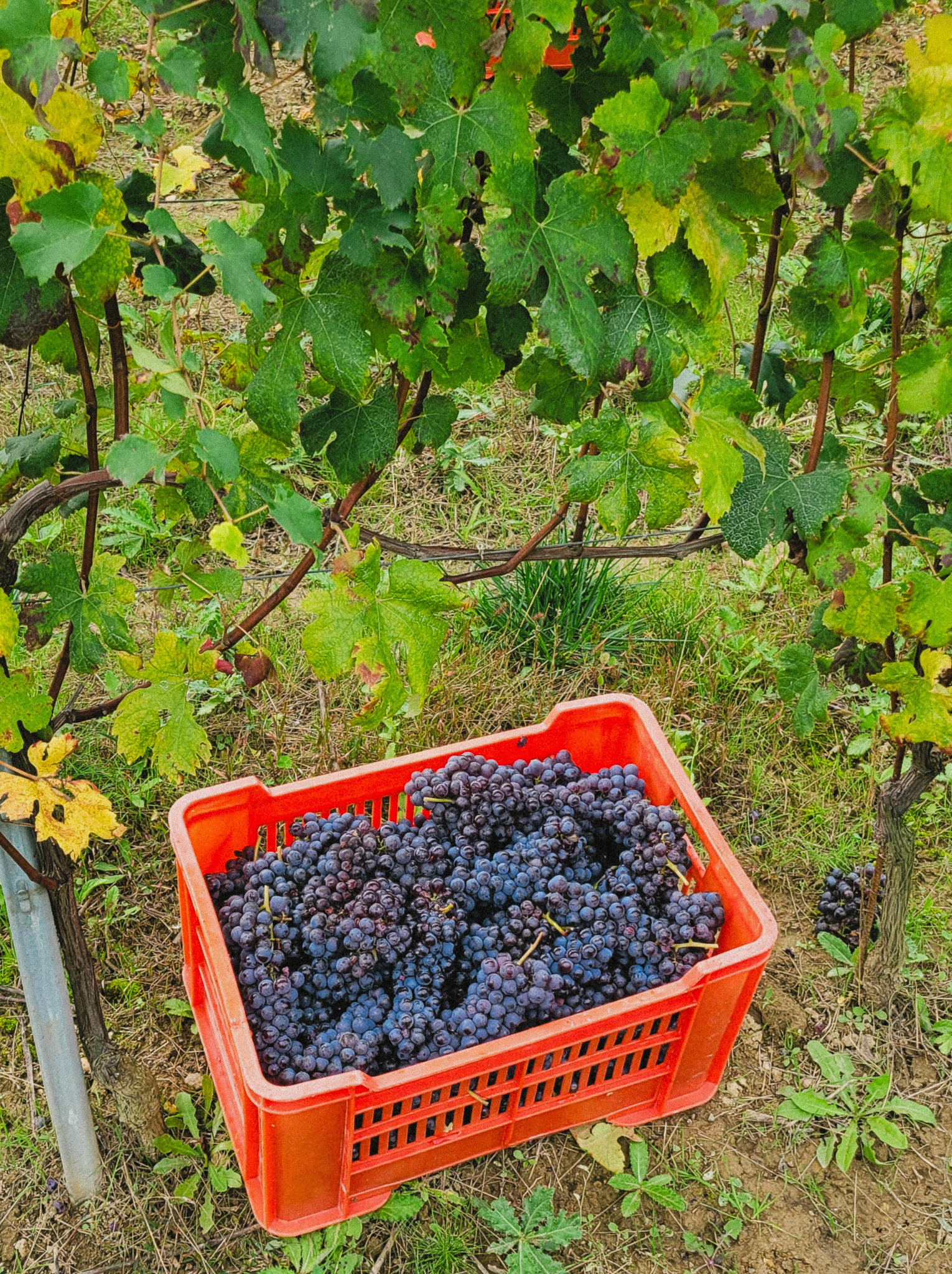
My reflections are interrupted when a pair of gloves and trimmers come into my line of sight. I stop waxing poetic and switch into work mode. Viviana shows me what we’re doing–every grappolo is to be cut and assessed before being added to the crates and moving down the line, working in pairs to fill the crate and move it to the other side of the row when full. The cutting is easy–one gloved hand lightly but firmly scoops the bunches while the other trims the stem, removing it from the vine. The assessment is more difficult. This season brought humidity, rain, and hail, translating to moldy patches and dried up and unripe berries. Some bunches fit easily in the palm of my hand while others require draping over my forearm, leaving sticky grape juice from broken berries on my wrists and sleeves. I delicately turn and flip the bunches, exposing moldy pockets of fruits or dried berries that need precision trimming. Imagine playing Operation, but instead of using tweezers attached to a plastic game board to remove plastic body parts, you’re delicately holding the contents of a future bottle of Nebbiolo while balancing on a slope, calves stretched, slicing tiny parts of plant material away without rupturing any good berries. Oh, and the occasional earwig, ant, wasp, or spider hastily crawls out of said bunch onto your hand or arm to escape. It’s utterly raw, fresh, and precise work.
The task itself becomes routine. After our first row, I feel a natural rhythm taking hold and my doubt turns into confidence. If I’m unsure a bunch is fully ripe, I taste one: a burst of juice reveals itself as sweet or tart, followed by the tannic chewing of the skin. When I see brownish dots and white fuzz, I know beneath I may find a whole peduncle that needs removing. Scoop, hold, clip, snip, and drop flows like any other task I’ve done for my various jobs–folding pool towels, preparing sauces in squeeze bottles, labeling beer cans, assembling name tags. With a routine like this, it becomes easy to make conversation.
Cosa ne pensa delle elezioni? What do you think of the elections? Manca la tua casa? Do you miss home? Parla Piemontese? Do you speak Piemontese? I meekly respond with the only phrase I know–Basme ‘el cül (Kiss my a**)–which incites a surprised sprinkling of laughter. Francesco’s father-in-law explains Langhetto, and we talk of a variety of topics: his helping during the vendemmia, what he used to do for work, the dynamics of marijuana in Italy, his worries and hopes for his family and this landscape, the various waves of changing politics in the world.
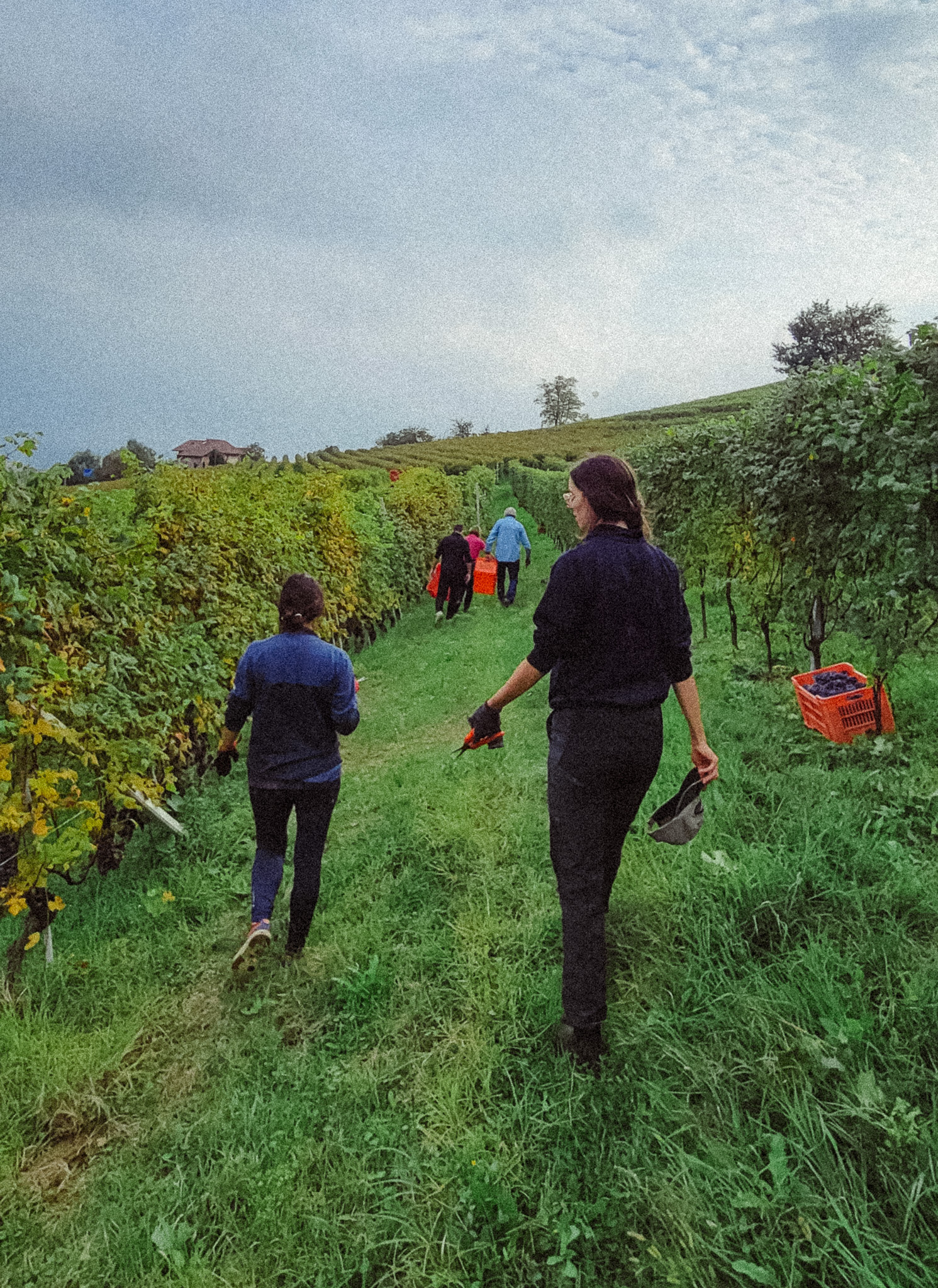
Time passes differently, counted in crates and lines of vines versus hour and minute. A shifting of bodies to the slanted, unplanted path indicates we are breaking for lunch. We gather by the pickup truck bed, rinse gloves and instruments from a jerry can of water, and head downhill to the cars to gather at Viviana’s mother’s home. Pulling in, we’re greeted by the two littlest members of the family, Riccardo and Leonardo, who are wreaking havoc on a pile of dirt and rocks with their trucks, an activity quickly abandoned when the prospect of lunch is announced.
The kitchen table is set for 15, maybe 16, peppered in bottles of water, baskets of bread, and beautiful, mismatched tableware. Leonardo and Riccardo have started a band, playing their forks and spoons off of the delicate plates, mom and grandma scolding. Viviana’s mother pulls things out of the oven, her daughter-in-law slicing and prepping things on a cutting board. My multiple offers to help are met with a waving of the hand and a directive to sit down and do nothing. So, I do.
Lunch consists of giardiniera, insalata russa, two types of pasta al forno, and tiramisu. It also consists of about four different ongoing conversations (one of which, fully in Langhetto, I can’t understand), two unruly boys messing around under the table, the clinking of flatware and silverware, and the opening of wine bottles and rolling of cigarettes. Viviana apologizes profusely for the chaos, but I couldn’t be happier. I haven’t been at a table this expressive and naturally familial in a long, long time.
Afternoon closes out with the rest of the harvest. I work again with Viviana, the spectrum of conversation spanning from gut-wrenching laughter to tears brimming on the eyes. As the vineyard is cleared of its grapes and the work slows down, Francesco and Giacomo run the tractor through the lines collecting crates full of fruit. We watch as they are loaded on the truck, crate topping crate, a towering of future wine before us.
Handshakes and salutations are swapped and the truck pulls away, leaving the vineyard empty and quiet. We’ll follow the grapes and the guys to the cantina, where the winemaking process will begin. Off we go again, curving through the Piemontese hills as the sun sets beyond the Alps and dusk settles in. We pass by countless other trucks filled with grapes–everyone is harvesting these days, a whole region plucking the landscape of ripe fruits with the hesitant hope of good wine on the way.
We wait for a tractor carting wine crates to pass us, and then we turn into a pizzeria parking lot. Viviana tells me this is where they’ll have dinner tonight. After a full day of harvesting, they have a full night of production. The process cannot be delayed. The moment fruit is picked, it begins to decay–slowly, of course, but nonetheless, the sooner the better. A slowly-rotting slough of juicy, sticky fruits won’t make for such a refined wine; fermentation should happen in the tanks, not in the crates. I’m exhausted just thinking about the night they have ahead of them, and fatigue hangs in the air as we enter the cantina.
Francesco and Giacomo are laboring over a long machine that sorts the grapes, stripping them from their stems and separating them. Leonardo is also there, his curiosity riding the line between sincere interest and youthful distractedness; he jumps at the chance to help move picked grapes into the machine, eagerly dropping more in without giving a preliminary visual once-over as Giacomo is instructing. Watching this are the others, dressed in waterproof gear, rinsing empty crates, and getting ready for their night of winemaking.
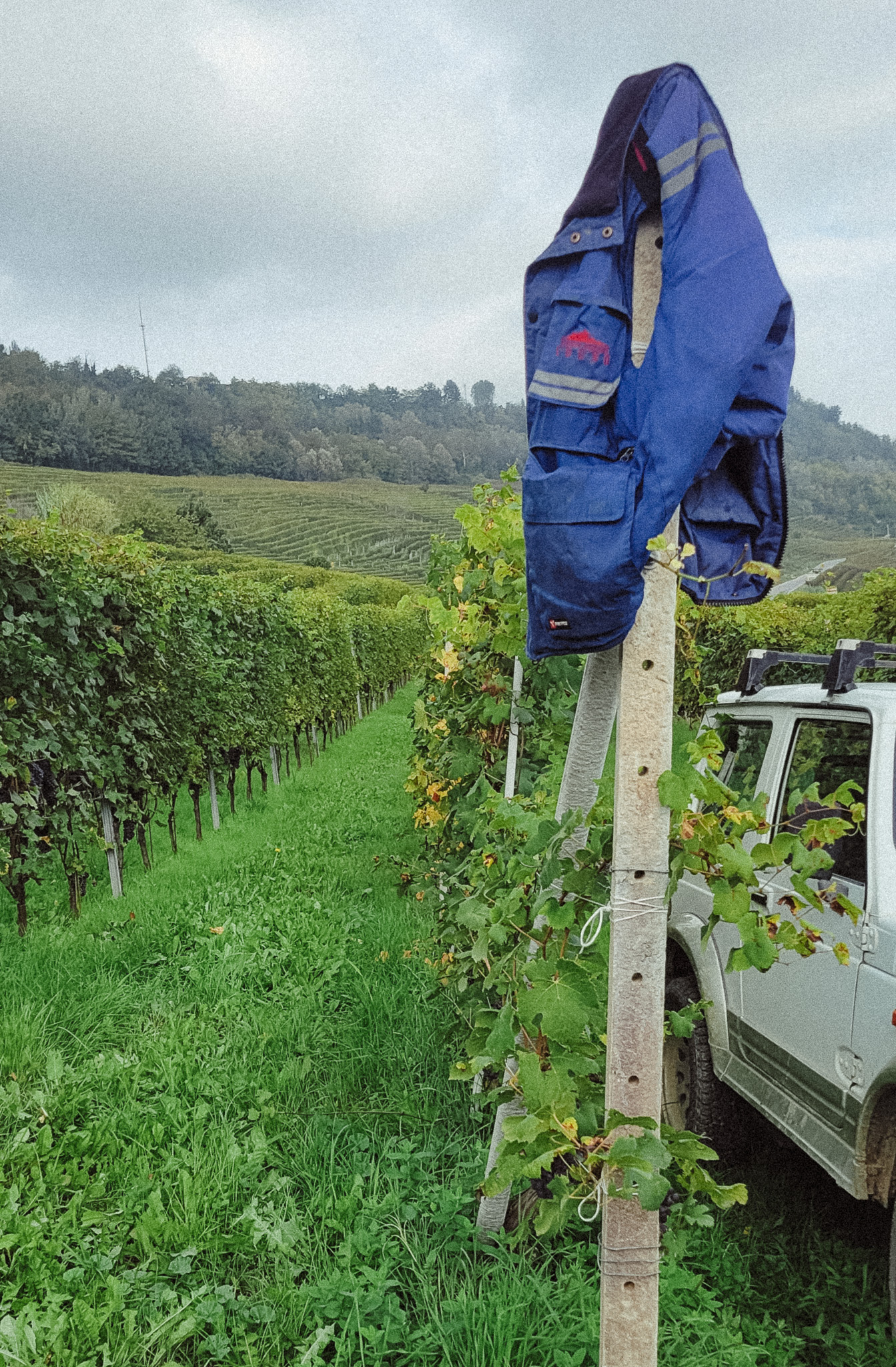
It all feels monumental and, at the same time, melancholic. To produce this year’s harvest might seem a big to-do, with happiness abound and cheer for the last phases–but this is an outsider’s expectation. The reality is more cut-and-dry: wine-making is a labor of love, literally. The labor is not easy: not on the body, the mind, the family, or the land. Everyone stands with slouched shoulders, tired faces, deep yawns. Attention spans are limited beyond focusing on processing these grapes. Tired moms and wives, who helped cook and harvest, are helping tired dads and husbands, who hauled crates and are fixing machinery. The grapevines hang onto nothing more than snipped strings and damaged leaves from mold, sunburns, and hail. I only harvested for one day; they’ve been doing this for days, months even, back-to-back-to-back, balancing their other jobs and families.
Francesco and Giacomo’s production is different from those of household name brands or larger producers in the region. The climate crisis for others, especially the giants, means they lose a few hundred bottles, maybe have subpar quality for a season, but nonetheless remain profitable. They can buy other land elsewhere, change grape variety or consumer markets, rebrand or sell off grapes to other brands.
But this land, this is Vaira land. Land their ancestors worked, where they were raised, where they helped on their first harvest many seasons ago like young Leonardo. When family wine producers talk about their production, their grapes, the seasons, their outputs, we should believe them. It is those who have direct intervention with the earth, day in and day out, who understand the changing landscape, the future of Piemonte production, and the future of their tradition of winemaking.
